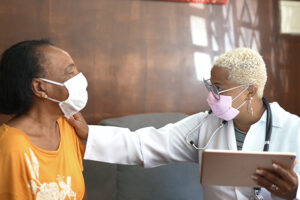Oncology
Chronic Myeloid Leukemia
BCR::ABL1 Tyrosine Kinase Inhibitors in Chronic Myeloid Leukemia: The Current Landscape
Overview
At the 64th ASH Annual Meeting and Exposition, emerging data on the treatment of chronic phase chronic myeloid leukemia (CML) continued to add to the knowledge base, guiding the use of BCR::ABL1 tyrosine kinase inhibitors (TKIs).
Following these presentations, featured expert Hagop M. Kantarjian, MD, was interviewed by Conference Reporter Editor-in-Chief Tom Iarocci, MD. Dr Kantarjian’s clinical perspectives on these findings are presented here.
Hagop M. Kantarjian, MDProfessor and Samsung Distinguished Leukemia Chair in Cancer Medicine |
|
“We can achieve most of our therapeutic goals in CML with the current frontline TKI therapies (ie, imatinib, dasatinib, bosutinib, and nilotinib).”
We can achieve most of our therapeutic goals in CML with the current frontline TKI therapies (ie, imatinib, dasatinib, bosutinib, and nilotinib). These agents normalize a patient’s survival, provided that the individual adheres to the TKI therapy, is properly monitored, and is appropriately switched to another TKI when there is evidence of failure. Additionally, with the use of these TKIs, we can aim to eliminate the disease and pursue the goal of a treatment-free remission (TFR), an end point that may be especially important for younger adults with CML.
When aiming for a TFR, the criteria for stopping therapy are still under discussion. The current trend is to define a deep molecular response (DMR) as MR4 or MR4.5 (ie, a reduction from the standardized baseline of ≥4 logs in BCR::ABL1 transcript levels). CML experts are also moving toward recommending a sustained DMR for at least 5 years, although other durations are being considered. Discontinuing TKIs after a DMR of 2 or more years is associated with TFR rates of 40% to 60%, whereas waiting until the patient has a DMR of at least 5 years before discontinuing the TKI is associated with a TFR rate of 80%.
Some patients with CML experience treatment failure with initial therapy, which may be due to side effects or resistance. This has been reported in approximately 20% to 40% of patients. In the United States, it appears that oncologists and patients are more willing to change TKIs more frequently because of their availability, while issues related to the costs and availability of TKIs may be more prohibitive of switching in other countries. With the Mark Cuban Cost Plus Drug Company, the current price of at least 1 of the imatinib generics (400 mg daily) is less than $500 per year in the United States. This is also the price of many imatinib generics in countries outside the United States. The price of patented TKIs ranges from approximately $150,000 to $250,000 per year.
Thus, when considering changing TKIs because of toxicities, an important question to consider is: Can we maintain a good molecular response and reduce toxicities through simply reducing the dose of the current TKI rather than switching the TKI? Likewise, when considering a TKI switch to obtain a more robust response in an attempt to achieve a DMR and a TFR, the question becomes: What cost is reasonable in that pursuit? This is where a discussion of the “treatment value,” or cost benefit, of TKIs comes into play.
Overall, resistance to frontline TKI therapy accounts for a relatively small proportion of all treatment failures in chronic phase CML. Our experience with frontline dasatinib shows that the 5-year cumulative resistance rate is quite low, as reported by Gener-Ricos et al at this year’s ASH meeting (abstract 619). Among 81 evaluable patients who were treated with low-dose dasatinib (50 mg daily) at our institution, the MR4 rate was approximately 84% and the overall survival rate was 98%; there were 2 deaths reported that were unrelated to CML and no cases of accelerated or blastic transformation. Nine patients increased the dasatinib dose to 100 mg daily to optimize molecular response, and only 5 patients switched to another TKI for suboptimal response/molecular resistance.
Subsequent-line therapy “failures” tend to occur in greater proportions due to toxicities, and the phenomenon of cross-intolerance may be relevant. In such cases, the art of medicine is important, and oncologists and patients should assess the side effects and titrate the TKI dose to maintain a good molecular response and to reduce or eliminate side effects rather than reflexively switching to a new TKI.
In abstract 333, we summarized our experience with third-line TKI therapy in 354 patients with chronic phase CML, focusing on the use of ponatinib vs second-generation TKIs in this setting. One-to-one propensity score matching was performed using covariates (eg, age at the time of third-line therapy, prior TKI therapy, duration of prior TKI therapy, and best prior response during the frontline and second-line TKI therapies, among others). We then compared outcomes in patients receiving ponatinib with outcomes in patients receiving second-generation TKIs in the third line. Individuals with T315I mutations were excluded, given the known resistance to all of the second-generation TKI therapies. Before and after matching, both the progression-free survival rates and the overall survival rates were higher with ponatinib than with the second-generation TKIs (dasatinib, bosutinib, and nilotinib). Additionally, by multivariate analysis, ponatinib therapy (vs second-generation TKIs) was an independent favorable factor.
Ponatinib is associated with a number of toxicities, including hypertension, pancreatitis, and skin rashes, among others. The initial US Food and Drug Administration (FDA) approval of ponatinib was for the 45-mg daily dose, but we have learned more recently through studies such as the OPTIC trial that ponatinib does not have to be used at the full dose of 45 mg daily continuously. This trial included patients with resistance/intolerance to 2 or more TKIs or with the BCR::ABL1 T315I mutation. An update from the OPTIC trial by Cortes and colleagues (abstract 620) showed that dose-adjusted ponatinib can provide efficacy that is similar to that observed with ponatinib 45 mg daily and can reduce side effects. Ponatinib can be started at 45 mg daily in T315I–mutated CML or at 30 mg daily in other scenarios and can be reduced to 15 mg daily once a complete cytogenetic response (polymerase chain reaction [PCR] <1%) is achieved. In this update, grade 3 or higher arterial occlusive events were reported in the 45-mg cohort (6%), the 30-mg cohort (6%), and the 15-mg cohort (4%); the rates were similar to the reported rates in the primary analysis of the OPTIC trial (ie, 45-mg cohort, 5%; 30-mg cohort, 5%; 15-mg cohort, 3%).
Asciminib has received recent FDA approval as a third-line therapy based on the open-label, randomized, phase 3 ASCEMBL trial comparing asciminib 40 mg twice daily with bosutinib 500 mg once daily in patients with chronic phase CML. The primary end point was a major molecular response (MMR) at 24 weeks, which was significantly higher with asciminib (25.5%) vs bosutinib (13.2%). Results with bosutinib as a control arm in ASCEMBL were worse than those reported in other trials of bosutinib, perhaps because of the FDA mandate to use bosutinib 500 mg daily rather than allowing dose titration, leading to higher-than-expected rates of bosutinib discontinuation.
The FDA approval of asciminib also extended to ABL1 T315I–mutated CML, but at a higher dose of 200 mg twice daily. The price of asciminib 200 mg twice daily is currently more than $1 million per year. Until the price becomes more reasonable, my view is that other treatment options should be considered in T315I-mutated CML. These include ponatinib, allogeneic stem cell transplantation, omacetaxine, cytarabine, hypomethylating agents, and hydroxyurea. While third-generation TKIs are the ideal approach in T315I-mutated CML, removing the TKI selection pressure can also result in the elimination of the T315I clone.
The third-generation TKIs have additional potential in CML that should be explored in the second line, post second-generation TKI resistance, and in the front line. Based on the ongoing trials, asciminib is showing high efficacy and safety, and CML experts are interested in exploring its value as frontline CML therapy. The CML13 ASCEND-CML trial from the Australasian Leukaemia & Lymphoma Group aims to include 100 patients with newly diagnosed CML who will be treated with asciminib (abstract 79). At ASH 2022, Yeung et al reported data from the first 79 patients treated in this study. With a median follow-up of 10 months, they showed favorable early molecular responses with asciminib (ie, BCR::ABL1 transcripts of ≤10% at 3 months). They compared these results with asciminib with results from their previously conducted trial in which all patients were started on imatinib 600 mg daily, noting a rate of approximately 94% with asciminib vs 86% with the 600-mg dose of imatinib. The data are encouraging, and we are interested to see how these rates will compare with those of second-generation TKIs such as dasatinib or bosutinib when used as frontline therapy. If asciminib is approved as frontline therapy in the future, its benefit-to-cost value (currently priced at $250,000/year for 80 mg daily) would need to be evaluated in relation to the benefits and prices of the imatinib and dasatinib generics.
Another important consideration is the comparative efficacies and toxicities of asciminib and ponatinib as subsequent-line therapies, post resistance to second-generation TKIs. The 2 TKIs have never been compared head-to-head using optimized dose schedules. Such comparative trials are urgently needed.
One of the most common debates posed in CML is how to treat a patient of a given age who is on a given TKI (eg, imatinib, dasatinib, bosutinib, or nilotinib) and whose BCR::ABL1 transcripts are anywhere from 0.01% to 0.5%. The reflexive reaction is to rotate TKIs or use a third-generation TKI (ponatinib, asciminib), and I think that this is because we emphasize achieving a complete cytogenetic response (PCR <1%) or a DMR (MMR or better), or to target a CMR in order to pursue a TFR. Being too aggressive has potentially harmful impacts, such as excess toxicity and financial toxicity. In my view, once a patient is determined to have a low probability of a TFR (ie, no durable DMR with 5 or more years of imatinib or a second-generation TKI), then changing TKIs runs the risk of financial toxicity and may even do harm if you switch to a TKI with greater toxicity.
In the aforementioned scenario, my course of action—which may be different from other CML experts—would be to not change the TKI; I would continue with the same TKI and monitor the patient’s PCR at 3- to 6-month intervals (ie, every 3 months if the PCR is >0.1%, every 6 months if the PCR is <0.1%). In abstract 4330, we reported on the long-term clinical impact of not achieving this in 131 patients who never achieved MMR within 2 years, and CML-related mortality was low among these individuals. Favorable outcomes were seen even among patients with BCR::ABL1 levels that were between 1% and 10% IS.
References
Bidikian A, Kantarjian H, Issa GC, et al. Outcomes of chronic myeloid leukemia with no major molecular response within 2 years of tyrosine kinase inhibitor therapy [abstract 4330]. Abstract presented at: 64th American Society of Hematology Annual Meeting and Exposition; December 10-13, 2022; New Orleans, LA.
Cortes JE, Apperley J, Lomaia E, et al. OPTIC primary analysis: a dose-optimization study of 3 starting doses of ponatinib (PON). J Clin Oncol. 2021;39(suppl 15):7000. doi:10.1200/JCO.2021.39.15_suppl.7000
Cortes JE, Deininger MW, Lomaia E, et al. Three-year update from the OPTIC trial: a dose-optimization study of 3 starting doses of ponatinib [abstract 620]. Abstract presented at: 64th American Society of Hematology Annual Meeting and Exposition; December 10-13, 2022; New Orleans, LA.
Cortes JE, Kim D-W, Pinilla-Ibarz J, et al. Ponatinib efficacy and safety in Philadelphia chromosome-positive leukemia: final 5-year results of the phase 2 PACE trial. Blood. 2018;132(4):393-404. doi:10.1182/blood-2016-09-739086
European Medicines Agency. Dasatinib accord. Accessed December 6, 2022. https://www.ema.europa.eu/en/medicines/human/EPAR/dasatinib-accord
Gener-Ricos G, Haddad F, Sasaki K, et al. Long-term follow-up of low-dose dasatinib (50mg daily) as frontline therapy in newly diagnosed chronic myeloid leukemia [abstract 619]. Abstract presented at: 64th American Society of Hematology Annual Meeting and Exposition; December 10-13, 2022; New Orleans, LA.
Haddad FG, Sasaki K, Issa GC, et al. Treatment-free remission in patients with chronic myeloid leukemia following the discontinuation of tyrosine kinase inhibitors. Am J Hematol. 2022;97(7):856-864. doi:10.1002/ajh.26550
Jabbour E, Kantarjian H. Chronic myeloid leukemia: 2022 update on diagnosis, therapy, and monitoring. Am J Hematol. 2022;97(9):1236-1256. doi:10.1002/ajh.26642
Jabbour E, Sasaki K, Issa GC, et al. Outcome of third-line tyrosine kinase inhibitors in patients with chronic myeloid leukemia in chronic phase: a propensity score analysis [abstract 333]. Abstract presented at: 64th American Society of Hematology Annual Meeting and Exposition; December 10-13, 2022; New Orleans, LA.
Jenei K, Lythgoe MP, Prasad V. CostPlus and implications for generic imatinib. Lancet Reg Health Am. 2022;13:100317. doi:10.1016/j.lana.2022.100317
Kantarjian H, O’Brien S, Jabbour E, et al. Improved survival in chronic myeloid leukemia since the introduction of imatinib therapy: a single-institution historical experience. Blood. 2012;119(9):1981-1987. doi:10.1182/blood-2011-08-358135
Kantarjian H, Paul S, Thakkar J, Jabbour E. The influence of drug prices, new availability of inexpensive generic imatinib, new approvals, and post-marketing research on the treatment of chronic myeloid leukaemia in the USA. Lancet Haematol. 2022;9(11):e854-e861. doi:10.1016/S2352-3026(22)00246-0
Réa D, Mauro MJ, Boquimpani C, et al. A phase 3, open-label, randomized study of asciminib, a STAMP inhibitor, vs bosutinib in CML after 2 or more prior TKIs. Blood. 2021;138(21):2031-2041. doi:10.1182/blood.2020009984
Shih Y-CT, Cortes JE, Kantarjian HM. Treatment value of second-generation BCR-ABL1 tyrosine kinase inhibitors compared with imatinib to achieve treatment-free remission in patients with chronic myeloid leukaemia: a modelling study [published correction appears in Lancet Haematol. 2020;7(1):e11]. Lancet Haematol. 2019;6(8):e398-e408. doi:10.1016/S2352-3026(19)30087-0
Yeung DT, Osborn MP, White DL, et al; Australasian Leukaemia and Lymphoma Group. TIDEL-II: first-line use of imatinib in CML with early switch to nilotinib for failure to achieve time-dependent molecular targets. Blood. 2015;125(6):915-923. doi:10.1182/blood-2014-07-590315
Yeung DT, Shanmuganathan N, Reynolds J, et al. Early and deep molecular responses achieved with frontline asciminib in chronic phase CML – interim results from ALLG CML13 ASCEND-CML [abstract 79]. Abstract presented at: 64th American Society of Hematology Annual Meeting and Exposition; December 10-13, 2022; New Orleans, LA.
This information is brought to you by Engage Health Media and is not sponsored, endorsed, or accredited by the American Society of Hematology.











